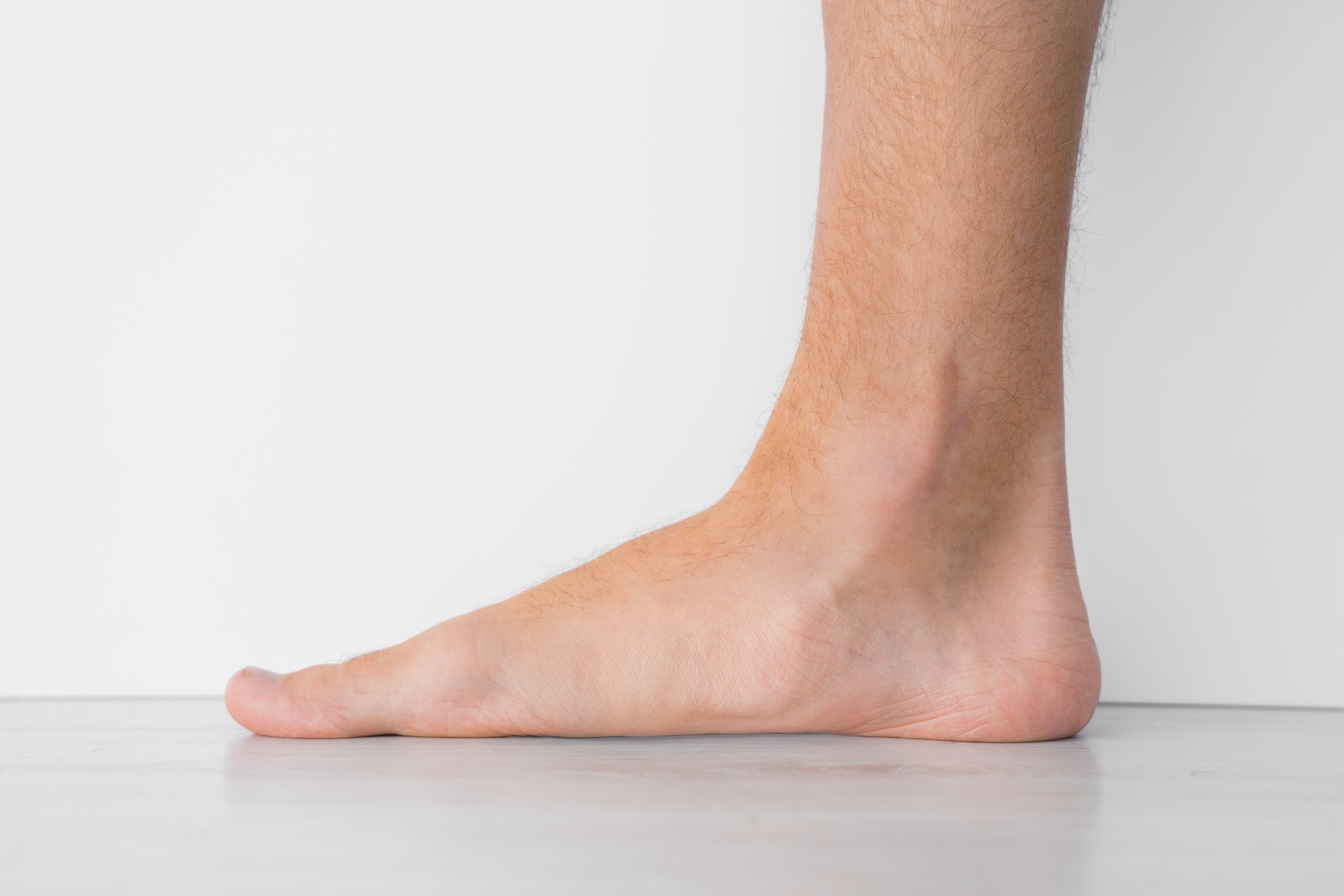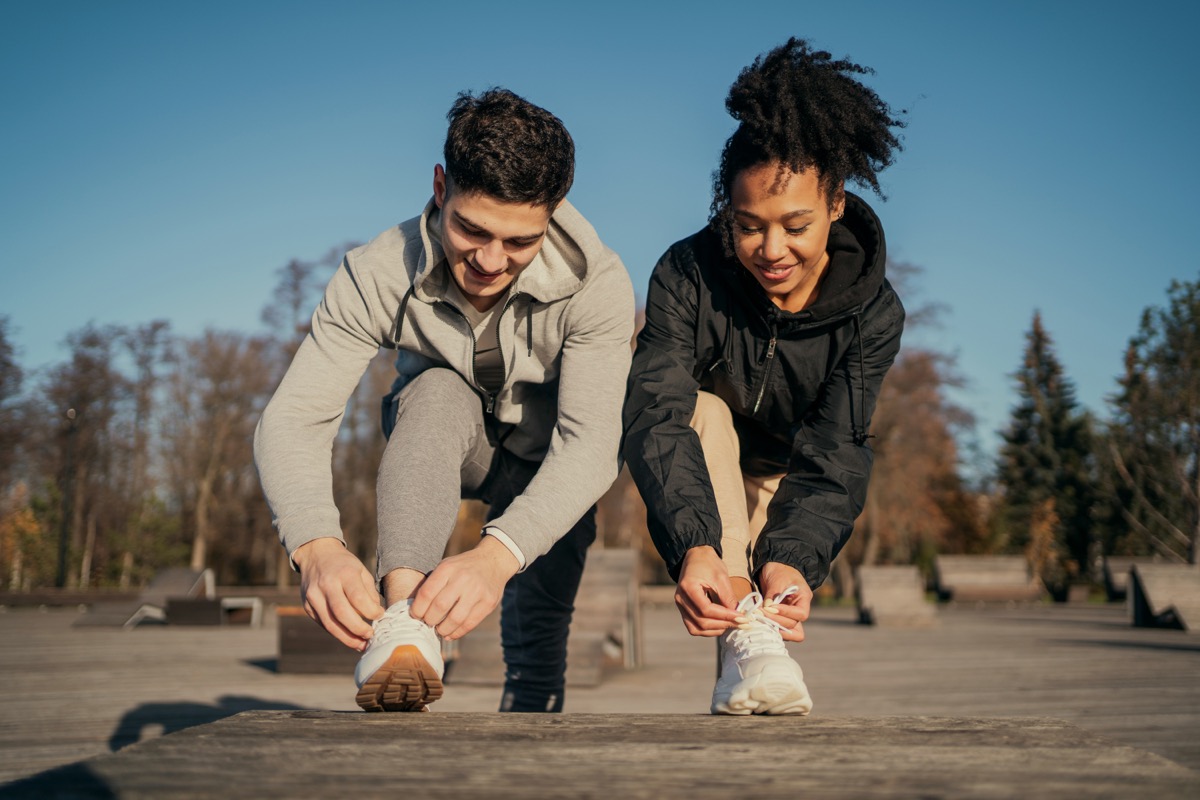5 Best Shoes for Flat Feet, Podiatrists Say

Even if your feet are pretty much standard issue in shape, finding the right running shoes with optimal fit, structure, and arch support can help you avoid pain and lower your risk of injury and gate problems. If you happen to have flat feet, snagging the right pair of shoes is of even greater importance. In that case, it’s crucial to shop strategically for thoughtfully designed footwear, podiatrists say. Read on for the five best shoes for flat feet, along with the condition’s common causes and how it could be affecting your health.
RELATED: 5 Best Shoes for Knee Pain, Podiatrists Say.
Causes for flat feet

The majority of the time, flat feet is hereditary, meaning people are born with them.
However, John Felidi, DPM, a board-certified podiatrist at Scarsdale Medical Group and White Plains Hospital Physician Associates, points out that flat feet can have many causes, including injuries, aging, and pregnancy. “Other risk factors include obesity, diabetes and rheumatoid arthritis, to name a few,” Felidi tells Best Life.
Lori Grant, DPM, a board-certified foot and ankle surgeon, adds that arthritis and tendon issues are also common causes of flat feet.
Overpronation, gate changes that are often the result of mildly flat feet, can also perpetuate the cycle by causing the feet to become even flatter with time.
Are there different types of flat feet?

There are two different types of flat feet: Flexible and rigid.
“Flexible means you have a normal-looking arch when seated, but when you stand up, the foot arch collapses and the foot is flat. Rigid means the foot is flat at all times,” explains Grant.
To determine which type you have, you can try bearing weight on the foot to see how it responds. However, visiting a podiatrist for a professional examination is the best way to determine whether you have flat feet and, if so, which kind.
RELATED: 9 Comfiest Sandals You Can Walk in All Day, Podiatrists Say.
How flat feet affect your health

Having flat feet can affect the feet themselves, as well as the legs, hips, and back.
“Flat feet can lead to a number of complications such as toe deformities like bunions and hammertoes. The condition can affect the tendons and ligaments in our feet and ankles, causing sprains, instability, plantar fasciitis, and tendonitis, and can lead to both acute and chronic pain in the feet, ankles, knees, and hips,” says Felidi.
One reason for this is that having flat feet affects your gait, or your manner of walking.
“I like to say that the feet are the foundation, so when the foundation is off, it affects everything above it. It causes more stress on the inside of the foot and ankle, thus causing more pressure on the knees, hips, and lower back, thus causing pain in each of these areas,” Grant tells Best Life.
She adds that if you have flat feet, you may notice that your feet get tired faster or experience heel pain, shin splints, or burning on the bottoms of the feet when standing for too long.
“It can also cause the forefoot—the area where the toes are—to become wider or cause the foot to splay out, thus making it harder to fit shoes,” she adds.
RELATED: 5 Best Shoes for Plantar Fasciitis, Podiatrists Say.
What to look for in a shoe if you have flat feet

If you have flat feet, you may have different needs when it comes to shoe shopping. Felidi says that since people with flat feet tend to have wider feet, it’s important to look for shoes with a wider toe box, arch support, and heel support that fit comfortably.
Grant adds that when shopping for athletic shoes or sneakers, you should always look for brands with good stability, as well as arch support.
In general, it’s best to avoid sandals or flip-flops. But if you do plan to wear them from time to time, you should be sure to choose pairs with a thicker sole and arch support.
“When you look at the shoe from the side, you need to see a ‘hump’ in the middle of the shoe where your arch should be,” Grant says.
As for dress shoes, skip any style with a flat sole—for instance, ballerina flats. You should choose shoes that have a small heel or thicker sole, not to mention arch support and good cushioning.
RELATED: I’m a Podiatrist and These Are the Best Shoes for Foot Pain.
The 5 best shoes for flat feet
Paul Macaulay, MPod, a British podiatrist based in Singapore, recently took to TikTok to share his top five shoe recommendations for people with flat feet. These are his favorite sneakers for enhancing comfort and reducing injury related to flat feet.
1. ASICS Kayano

Podiatrists often recommend ASICS athletic shoes to people who have plantar fasciitis, bone disorders, and gait disorders because they tend to promote stability and provide a more comfortable stride. Several styles, including the ASICS Kayano, have earned the American Podiatric Medical Association (APMA) Seal of Acceptance, which indicates that they have been doctor-reviewed and found to promote foot health.
People with flat feet may benefit most from one feature in particular: what ASICS calls LITETRUSS technology. This improves medial support and midfoot integrity, giving much-needed support to those with flat feet.
2. New Balance 860

New Balance 860s are another top option for people with flat feet, according to Macaulay. In fact, many customers say they bought these super-cushioned yet stable sneakers based on their podiatrist’s recommendation.
3. ASICS GT 2000

Another ASICS shoe that Macaulay recommends is the ASICS GT 2000, a running shoe that’s often lauded for its stability and effectiveness in improving overpronation.
According to ASICS, this sneaker”consists of wider basenets and an increased heel bevel and forefoot flare. As a result, you’ll experience a silky-smooth transition from footstrike to toe-off.”
4. Brooks Adrenaline

Brooks Adrenaline shoes also come highly recommended for those with flat feet. Macaulay says they’re one of the top five shoes he recommends to patients with the condition. Like several ASICS models, this particular shoe has the APMA Seal of Approval and is often touted for its support and cushioning.
5. Saucony Tempus

Saucony Tempus running shoes are Macaulay’s final recommendation for those with flat feet. These use PWRRUN PB, a type of low-density “super foam” that adds durability and bounce to the shoes’ soles, as well as a PWRRUN Support Frame, which provides added support.
- Source: Cleveland Clinic: Overpronation